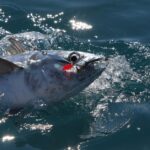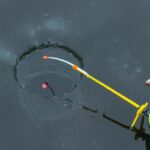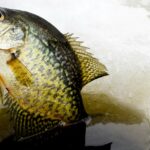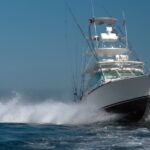A suitable fishing rod is a key to angling success. While quality is important, using the right rod type is even more necessary.
An F1 car is crazy fast, but it’d be silly to take it to the Dakar Rally and expect it to win, the same way you can’t expect a rusty spinning rod to snag you some Bluefin Tuna. Many types of fishing rods exist, each for a particular use, situation, and fishing style.
Telescopic rods transport easily; spinning and casting rods use different reel types, while ice fishing rods are the best for icy conditions. Alongside other fishing pole types, this article explains their various uses.
Spinning Rods
Spinning rods are amongst the most common rod types for fishing. They are excellent for newbies because they allow you to use them with your dominant hand, ensuring more stability and power.
The spinning reel stays on the rod’s bottom when reeling or casting. It’s easy to cast with this general-purpose rod because it’s simple to master without spending hundreds of hours practicing.
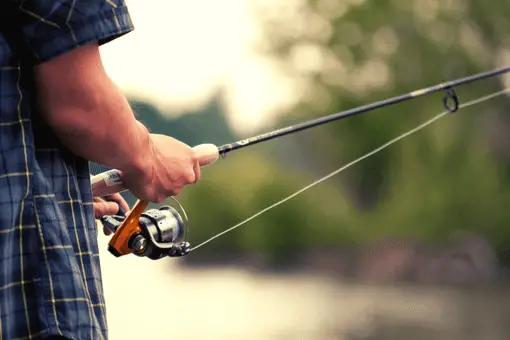
Beginners love this rod because of its broad use in freshwater fishing. It’s a hobby rod suitable for lazy days in the river or lake and useful in almost any fishing situation.
Depending on the rod size, you might catch some decent-sized fish, especially when paired with a thicker line. Spinning rods are suitable for snagging popular fishes, including walleye, trout, and bass.
Pros
- Effective for lightweight lures
- Exceptional in windy conditions
- Easy to control
Cons
- Not fantastic in difficult water
- Not the best for fishes larger than 10lbs
- Casting accuracy is limited
Bait Casting Rods
Firstly, this fishing rod isn’t suitable for beginners. Moreover, these rods are more effective when paired with a baitcasting reel. This fishing rod type uses a baitcasting reel to cast bait and line.
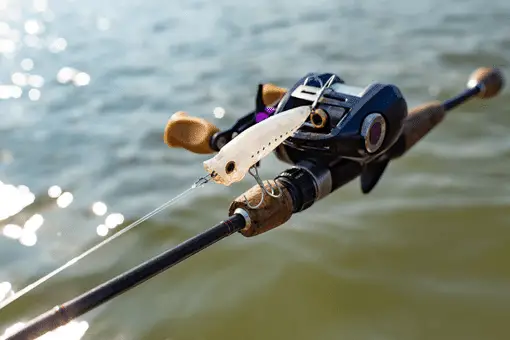
Still, it offers a greater casting distance, including better control over the hook and line. The benefits are enormous despite the steep learning curve.
You can catch larger fish while using more efficient and effective fishing techniques. Tangling lines is the worst fear for many baitcasting anglers because of the mess of lines that’s often impossible to untangle.
Pros
- Ability to cast long-distance
- Exceptional with heavy lures
- Durable design
- Incredible casting accuracy
Cons
- Can be difficult for beginners to learn
- Higher risk of casting backlash
- Spool tension requires adjusting for various lure sizes
Trolling Rods
Trolling rods are the type you see attached to a boat. This rod is designed to snag suspended fish and must deal with the boat’s speed and movement, including the weight of a large fish moving against the boat’s direction.

That’s an incredible amount of weight hence the need for specialized equipment. Trolling rods are the best for catching monsters, including tuna, marlin, and sailfish.
You see these fishing rods on shows like Wicked Tuna, and it’s suitable for ocean fishing. Many trolling rods move the bait at a particular depth to lure predatory fish and work better with heavier lines. The drawback of this fishing rod is that it’s only good for specialized fishing.
Pros
- Excellent for snagging difficult and larger fish
- Durable and can withstand greater forces
- Fantastic for troll-fishing
Cons
- Very limited use
- Expensive for a beginner
Surf Casting Rods
A surf casting rod is unlike any other fishing rod on the market. This fishing rod is designed for shore fishing, built with long casts for fishing on the ocean.
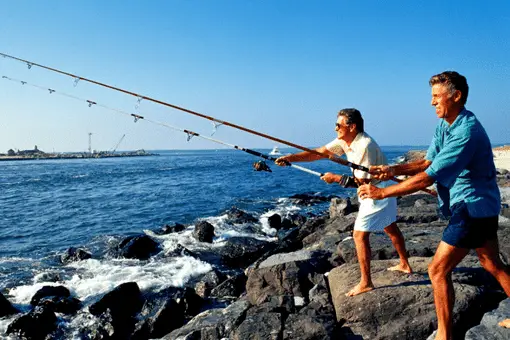
Surf casting rods are extremely rugged and durable, with premium corrosion-resistant fabrics that withstand saltwater damage.
These rods are part of the sea rod family and feature a long stem, increasing the casting depth. Various surf rod types depend on the fish.
Still, all are generally difficult to master and pricey, which may not be the best for a beginner fisherman.
Pros
- Excellent reaction to wrist movement when casting
- Incredible grip and smooth reel
- Durable corrosion-resistant material
- Holds firm even for large fishes
Cons
- It’s expensive
- Not easy to transport
Fly Fishing Rods
Fly fishing rods are renowned for their lightweight design and versatility, making them suitable for various fishing environments, including lakes, ponds, rivers, and the ocean.
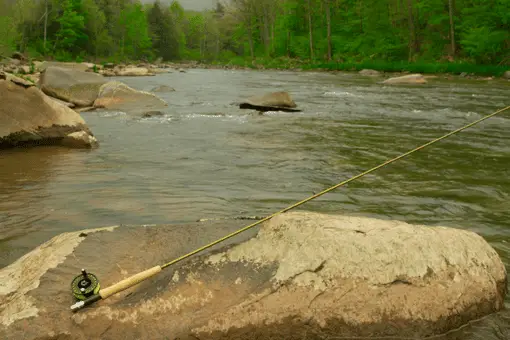
The fishing tool is adjustable for different sizes and weights of fish, making these rods general-purpose. The versatility of the fly fishing rod is its hallmark, ensuring it’s one of the go-to choices for experienced anglers.
Interestingly, it’s possible to cast these rods at great distances using the lightest flies because it doesn’t depend on the lure’s weight to travel.
The drawback is the learning curve required to master this casting technique. Moreover, you need significant space to practice, or you’d spend more time getting your flies out of the bushes than fishing.
Pros
- Available in various lengths
- Stealthier than most spinning rods
- Cheaper flies than lures
Cons
- Steep learning curve
- Requires significant room to cast
Ice Fishing Rods
Ice Fishing is a traditional fishing style that requires the shortest rod type because of the short coverage distance. These ice fishing rods are lightweight and extra-sensitive to feel the tiniest twinge on the line.
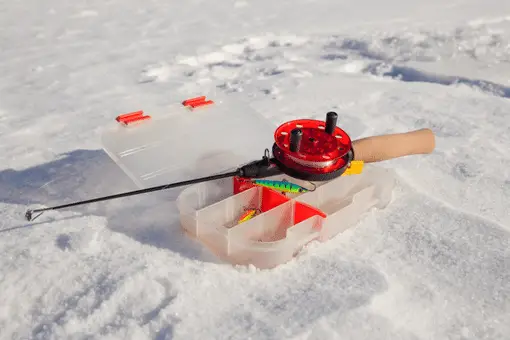
It isn’t uncommon to find rods less than three feet long with inline reels for the smallest spaces. Still, these rods are only suitable for snagging medium-sized and even small fishes.
Larger fishes are out of the question and will snap under the fish’s weight. Still, it’s possible to find ice fishing rods built to fight large fish under the thickest ice. This rod type is easily affordable and even easier to master.
Pros
- Excellent for confined spaces
- Can withstand the coldest temperatures without freezing or cracking
- Suitable for small and medium-sized fish
Cons
- Not built to catch larger predatory fish
- Only good for ice fishing
Telescopic Rods
The standout feature of a telescopic rod is its portability. Many fishing rods get damaged in transport, hence the need for a collapsible rod for easy transportation without sacrificing length.
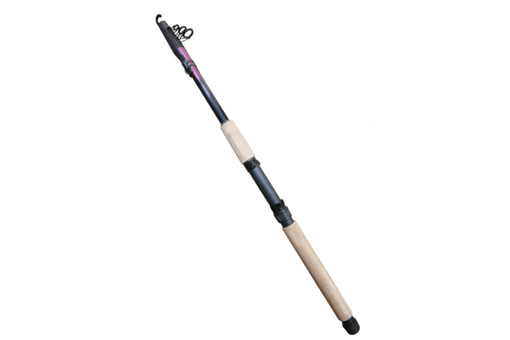
At their smallest size, telescopic rods are shorter than ice fishing rods but can be as long as surf fishing rods once you put them together.
Telescopic rods used to be for fishermen who preferred to fish in the remotest locations, hiking many miles to their fishing spot. Today, the fishing rod is mostly for convenience and is a suitable tool for the casual angler.
Pros
- Very affordable
- Portable and easy to transport
- General purpose for various fish species
Cons
- The rod isn’t durable
- Multiple sections make it easier to fail
Boat Rods
Boat rods are not so different from troll rods because of their effectiveness for ocean fishing. However, boat rods are typically short without any need to be cast into the ocean. Lower your hook and weight over the boat, and it’s ready to go.
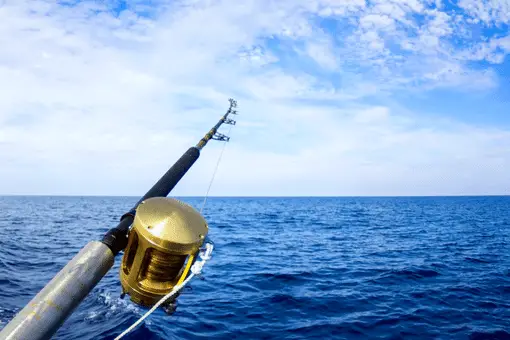
Fishing rods of this nature are heavy-duty, designed to wear down trophy-sized fishes in the deep ocean. They require tremendous power to pull such heavyweight fishes from great depths.
Consequently, boat rods use traditional reels that take heavy lines and feature corrosion-resistant components, including the line guides and reel seat.
Pros
- Heavy-duty fishing rod to battle the ocean’s toughest fishes
- Durable and lasts for an extended time
- Easy to set up
Cons
- Only for specialized use
- Not for casual fishing
Fishing Rod Weight Rating Explained
The fishing rod weight rating is the weight required to bend the rod. The lowest rating is Ultra Light, while the highest rating is Extra Heavy.
Consequently, it would help if you had a lighter rod to catch smaller fish and a heavy rod to snag bigger monsters.
Still, rod weight isn’t the only thing that matters. You also need to consider reel size, lure weight, and line weight which further finetunes what you need from a fishing pole. It would be best if you didn’t mistake the rod weight for fishing rod action, which shall be explained.
Most fishing rods spot a set of numbers, with the first number telling you the rod type. The second number recommends the best line weight to pair with the fishing rod.
Finally, the third number gives you the optimum lure weight. Understanding these numbers will help you choose your fishing pole better for the fish you want to catch.
Fishing Rod Weight Chart
| Rod Weight | Line Weight | Lure Weight | Best for Fish |
| Ultra-light | 1-4lbs | 1/64 -1/16oz | Trout & Panfish |
| Light | 4-8lbs | 1/32-1/8oz | Small Bass, Perch, Trout |
| Medium | 6-12lbs | 1/8-3/8oz | Pike, Lake Trout, Walleye, Bass |
| Medium-Heavy | 8-14lbs | 3/16-1/2oz | Catfish (casting), Pike, Salmon |
| Heavy | 15-25lbs | ½ – 1½oz | Pike, Muskie, Salmon (trolling) |
| Extra-Heavy | 25lbs and above | 1½ oz and above | Large Bass, Tuna, Heavy casting and above |
The table above lists the common fishing rod weight and size, including the recommended lure and line weight.
Fishing Rod Action Explained
Action is one of the critical performance indicators of a fishing rod. Action signifies the rod shape and material, including where and how it will bend against the weight of pulling fish.
Rod action also regulates the time it takes for the rod to bend and straighten to its normal position. This time factor determines whether a rod has a slow, medium, or fast action.
Fast Action
A fast-action rod is the most sensitive of the lot, and the smallest nibbles will vibrate your hand. These rods bend below the tip, snap back instantly, and are suitable for powerful hook setups.
A fast-action rod is more effective with a single hook, including large jigs and worms. Moreover, the strong spine ensures you can target large freshwater fish, including Muskie and Largemouth.
Medium Action
Medium-action rods bend at the pole’s upper half. They offer exceptional feedback with top-notch hook-setting capabilities and decent casting.
Medium-action rods don’t provide instant feedback, thus allowing the fish more bite time. These fishing poles are versatile and useful in various water bodies.
Slow Action
Slow-action rods bend at the butt, making it fun to battle the tiniest water critters. You’ll love this fishing rod if you enjoy angling for trout or panfish.
Slow-action rods showcase your casting capabilities. Slow-action rods work well with small lures because of the time required to operate the hook into the fish’s mouth.
The drawback of this rod is the difficulty in setting the hook. Still, the tension is far easier to control when the hook is worked into the fish.
Fishing Rod Power Explained
Rod action and power work hand in glove but are two different things. Rod power is the amount of force required to flex the rod.
Various rod powers are designed to work with varying sizes of line and lure weights. Light power pairs well with light tackles for trout and panfish.
Medium power requires common lures for walleye and bass. Heavy power handles larger baits for catfish and pike. In sum, bigger fishes need more serious power and vice versa.
What Are Fishing Rods Made Of?
Fishing rods are typically manufactured from fiberglass, graphite, and composite.
Fiberglass
This fabric is one of the oldest and immediately offers enormous power for heavy-duty saltwater angling. Sea rods commonly use this material because of its toughness, that’s perfect for large fish. However, it doesn’t have as much give, and the stiffness can cause the fish to break away.
Graphite
Graphite is a light material and offers stiffness that improves casting accuracy. The lightness of this rod allows you to cast for hours without fatigue.
It’s a suitable rod for ultralight fishing using fast-action techniques. Graphite rods are pricier than fiberglass but are more brittle and can snap under the strain of a large fish.
Composite
Composite combines the best features of graphite and fiberglass without retaining either weakness. Still, the rod’s performance mostly depends on the build quality. It often hovers between graphite and fiberglass for effectiveness and price.
Frequently Asked Questions
Here are the answers to some common questions about types of fishing rods.
What is the strongest fishing rod made of?
The strongest fishing rod is fiberglass. However, some of the strongest rods on the market feature composite materials that combine the best of graphite and fiberglass.
What is the best type of fishing rod for a beginner?
Spinning rods are the best for newbies because they allow longer casts with the lightest lures. These fishing rods are easily affordable for beginner fishermen.
Does an expensive fishing rod make a difference?
An expensive rod sure counts for something in the angling world. The additional cost offers a higher sensitivity, exceptional construction, and a longer length to cast even further. You also get superior fish control and the ability to drop the lure with deadly accuracy.
- Do You Need An Indicator For Nymph Fishing? - November 16, 2023
- Fishing Safety Tips For Families - September 25, 2023
- What Is The Best Time To Night Fish At A Lake? - September 18, 2023


